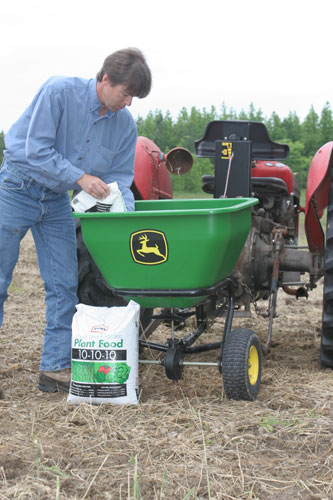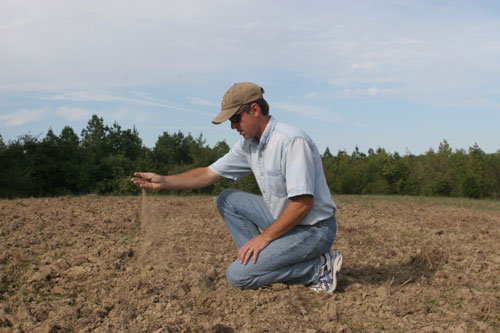
Of course, anyone who tried to grow a food plot in a wide swath of the United States knew exactly how hot and dry it was. They watched their time, effort and money shrivel into a patch of crispy plants and powder-dry dirt as arid days stretched into weeks and then into months.
Short of installing an irrigation system, there wasn’t a thing anyone could do about it. Even full-time farmers with a lifetime of knowledge and tens of thousands of dollars worth of equipment couldn’t grow a crop of corn or beans last year because even the most drought-resistant strains of corn or beans won’t survive the most extreme conditions.
The good news is that while an extended drought can kill any hope of even starting a food plot, it will rain eventually. Until then, however, the only realistic option is to wait, pray and wait some more, because sowing seed on desert-dry soil will do nothing but feed the birds.
Dirt Matters
What you can do, says former Georgia Department of Natural Resources deer project leader Kent Kammermeyer, is make sure your existing plots have every advantage possible before they are hit by a drought. That means giving them the proper nutrients in the form of fertilizer.
“Healthy plants will come through a drought far better than plants that are either stressed or unhealthy. The best way — really the only way — to determine if your plants are getting the proper nutrition is to conduct a soil test and then follow through with the recommended fertilizer and lime rates,” says Kammermeyer, who now runs a deer and habitat management consulting business (www.deerconsulting.com). “If you just start throwing down fertilizer without knowing if it’s the right mix of nitrogen, phosphorous and potassium, you are not only throwing away money, you might actually be doing more harm to your plots than you realize. Using the wrong amount or type of fertilizer will stress your plants.”
It’s equally important to match your plants to the soil. Clover, chicory or beans will grow just about anywhere under ideal conditions, but under drought conditions, those same plants will likely fail if they are planted in the wrong soil. Some regions have dense, clay-based soil, while others have loose, sandy soil, which doesn’t hold moisture well. That’s why it’s important to match your plant to the soil type. Clover, for instance, does best in dense soil that stays moist, while alfalfa prefers loose, sandy or other well-drained soil.
Cacti, And Other Options
Choosing the right plant for your soil type is pretty easy. Every seed manufacturer offers varieties of plants they list as “drought-tolerant” or even “extremely drought-tolerant.” Those descriptions are generally accurate, but take them with grain of salt. While some plants can certainly weather a dry spell better than others, it takes at least some moisture to sprout seeds and then more rainfall to bring them to maturity. If you haven’t had rain, you might as well plant a field of cacti.
Kammermeyer says spring-planted annuals like forage beans, peas and sunflowers are most vulnerable to dry weather and can wither and die if they don’t get adequate rainfall. Those same annuals can thrive if they get enough moisture early in their growing stage. Once the dry weather sets in, however, they will likely perish, but not before providing critical nutrition to nursing does and bucks during the antler growth stage.
Fall-planted annuals are the best all-purpose choice, says Kammermeyer, mostly because cooler autumn weather is usually accompanied by at least some rain. Once they sprout, plants like brassicas, turnips and tillage radishes send tap roots deep into the ground and soak up moisture far below the surface, and they can survive all but the most extreme autumn or winter drought. Kammermeyer’s favorite is a tillage radish that can send roots two feet or more into the ground. The thin root system provides the plant and tuber with enough moisture to survive.

Chicory and alfalfa, both perennials, are also excellent choices, particularly those cultivated as deer forage plants. They both develop deep roots and can withstand drier conditions than most other food plot plants. They will go dormant during the dry summer months, but once they get some rain, they will grow with vigor and provide ample forage for your deer herd. Make sure you choose a variety designed specifically for deer hunting, though. Brands like Whitetail Institute’s Alfa Rack or Chic Magnet are more palatable to deer and provide higher protein levels than varieties sold as cattle forage. Both are perennials that can last three to five years before they need to be reseeded.
Clover will also go dormant during the summer, but because it tends to have a shallower root system, it can’t withstand extreme heat and drought. Once it dies, it won’t grow back. It will, however, weather a moderate drought just fine and will spring back to life once it gets a little rain and some cooler weather in the fall, particularly if it is planted in the right kind of soil.






